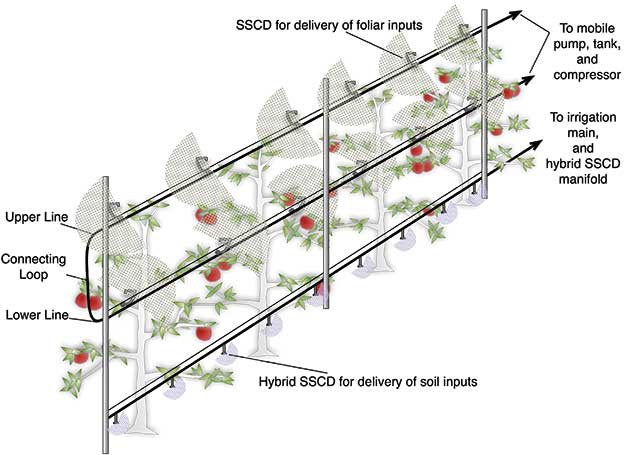
The solid-set spray system was shown in action last year at field days attended by growers. This one was at the Michigan State University experiment station at Clarksville.
After a year of work, the team of researchers developing Solid-Set Canopy Delivery Systems has issued its first report—and the results look promising.
Control of codling moth and mildew was “not quite as good” as airblast sprayer application, but acceptable, the report says. Coverage for most foliar inputs was adequate. Sunburn protection was comparable, but postbloom thinning was less complete when materials were applied by SSCDS. Beneficial mite populations were higher.
Some things need tweaking as the project proceeds.
As part of the project, surveys were mailed to apple growers in Michigan and Washington, asking their opinion about the idea of having an orchard spray system permanently installed in place, rather than driving tractors and hauling sprayers up and down orchard alleys multiple times each season.
Nearly 500 growers, representing 40 percent of the apple acreage in the two states, responded. They said they’d consider installing such a system, especially if they already have a trellis system in place to support it.
Focus groups in Michigan, Washington, and New York wanted to know more: How much will it cost to establish and maintain? Can it be adapted to different size blocks and trees? How much knowledge and training will managers and field workers need to operate and maintain the system?
From the researchers’ point of view, the results will help them refine the system. And one more experimental possibility will be tested this year: Can the system be used in the spring to apply water as a cooling mist to delay bud development and avoid late spring freezes?
In Michigan, freezes were so devastating in 2012, there was virtually no fruit on which to test the spray system’s ability to control insect and disease pests. Most of that work was done in Washington. This spring, dormancy was extended by cold weather, but a damaging freeze did occur on May 13, so test conditions were in place.
Moreover, installations have been made at several growers’ orchards, so new tests will be made using field-scale, commercial conditions.
Evolved quickly
The project is being conducted in three states, led by project directors Drs. Matt Grieshop at Michigan State University, Jay Brunner at Washington State University, and Art Agnello at New York’s Cornell University.
Already 15 years ago, Agnello had tested a fixed-in-place spray system using irrigation lines and sprinkers to apply pesticides. But when the SSCDS systems were installed last year at Michigan State’s Clarksville Experiment Station and Washington State’s Prosser site, the design was far advanced from a few lines and sprinklers strung through the trees.
The new designs were the concept of John Nye of Trickl-eez Irrigation in St. Joseph, Michigan, and based on work done by Art Agnello and sprayer specialist Dr. Andrew Landers at Cornell University.
Some practical problems needed to be solved. While it seems simple enough to spray pesticide solutions through irrigation lines and sprinklers, what happens next? How would the lines be cleared out? If clear water were used to flush the lines, would it wash off the newly applied spray material?
A novel method was developed, which consists of two major components:
1) the canopy delivery system and 2) the applicator.
The canopy delivery system is a network of polyethylene irrigation tubing run through the orchard block in a continuous loop with an input and output line that attaches to the applicator.
The applicator consists of three major components: 1) a pumping system, 2) an air compressor and 3) a tank for mixing, providing, and recapturing spray material for the canopy delivery system.
The four-stage spray procedure consists of the following steps:
1) Charging: Spray material is premixed in the spray applicator and then pumped through the main line at low pressure (less than 18 psi).
2) Spraying: The return line is closed and pressure increased to greater than 30 psi allowing the check valves to open and material to exit through the microsprayers for the time needed to apply 70-100 gallons per acre (less than 15 seconds).
3) Recovery: The return valve is re-opened, and the air compressor set at less than 18 psi to blow any fluid remaining in the main line back into the spray applicator.
4) Cleaning: The return valve is closed and the air compressor set to higher pressure (greater than 30 psi) to clear any remaining spray material out of the microsprayers.
Materials
While the microsprayer emitters are well developed, it is not clear what kinds of materials might need to be used in constructing the lines. They researchers tested both rigid PVC pipe used in plumbing and flexible polyethylene hose.
The microspinklers were spaced three feet apart on drop downs three feet long.
There was a somewhat larger pressure drop on the flexible polyethylene hose. “These data suggest that PVC is a superior material for SSCDS plumbing,” the report says, but polyethylene is widely used for irrigation and growers are adept at handling it.
Details about the project, and the first report, are available online at www.canopydelivery.msu.edu.


Leave A Comment